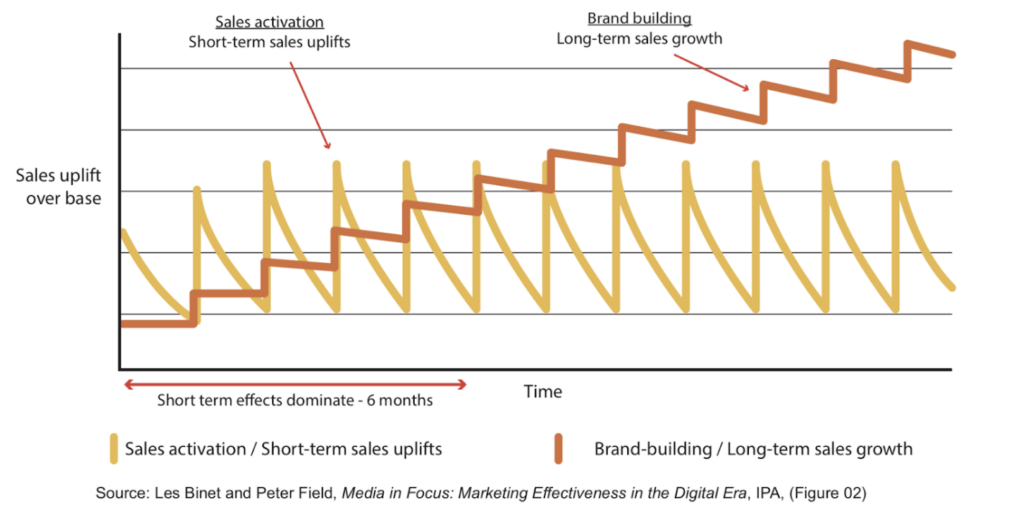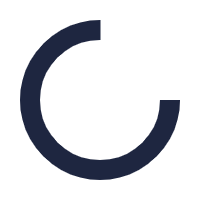Quick Read
- Many scaling organizations struggle with the challenge of financially justifying upper funnel brand investments that do not drive an attractive attributable CPA.
- When maxing out reach and performance on core performance channels, the natural next step is to move up the funnel, but the frameworks that got us here won’t get us there.
- In a majority of cases, we find that the crux of the struggle lies in an improperly structured blend of measurement approach, channel selection, and buying tactics.
- Applying a performance marketer’s mindset and a rigorous testing strategy paired with a multi-pronged measurement approach can establish incremental bottom-line impact that clears a path forward for continued investment.
- In our case study, we demonstrate how our approach drove a 190% YoY increase in branded search leads for a challenger brand in an established, competitive field, while unlocking evergreen brand investments across core channels.
- For a limited time, Headlight’s team of experts is offering a free strategic Audit Session across Growth, Creative & Analytics – a unique opportunity for brands to learn more about how to build growth through brand awareness and performance. Read through to sign up.
Starting on the right path
The first step when starting a new adventure, or simply getting to your next stop, is looking at a map.
But what if a map doesn’t exist?
This is what brand-building feels like to many scaling businesses. They know the destination (i.e. “make more people aware of our business”) but not the direction to go, or where to make turns along the way.
Balancing brand-building within the tradeoffs of a budget-constrained environment is a challenge we frequently discuss with the scaling partners that we work with. We all understand that building brand awareness is going to be key to expansion, especially once core performance channels are driving significant volume, but sustaining it will require a different approach.
The most famous example of this comes from studies by the “Godfathers of Effectiveness’, Les Binet and Peter Field, who designed the commonly referenced benchmark that an advertiser should spend roughly 60% of its marketing budget on Brand, and 40% on Performance activations – there’s more to the framework than this, but it’s generally known as the “60:40 rule”.
For earlier stage businesses, they argued that the brand weight should be even greater. This is because more work is required to explain a new product than for the recognized brands that were at the heart of their initial studies.
Brand-building and scales activation work over different timescales

But, even though we may know this, there are a number of substantial challenges that often halt historically CPA-reliant companies in their tracks.
- How do we get the budget for this? Capital is expensive and budgets are tight. Especially right now. To run any kind of brand building, we have to be able to prove incremental value and impact, particularly to internal financial stakeholders.
- How do we know what message to take to the market? In a world where we can’t run large focus groups among potential customers, we have to get some kind of feedback.
- Our Hollywood A-List owner is away on holiday right now and can’t shoot a video that will just turn everything around for us (less common).
You may have noted, our ability to measure effectively is a key thread underlying these challenges. Measurement will be our compass: telling us if we’re heading in the right direction.
So how do you take the first steps of measurable brand-building?
Avoid common brand-building mistakes
Everyone has a common story of seeing brand awareness budgets disappear with seemingly no impact.
We’ve heard of this a lot.
Often, this failure comes down to one or more of the following mistakes:
1. Running to poor measurement goals that do not correlate with business objectives. For example:
- Impressions and reach – these two metrics often don’t even indicate whether a user a) was human, or b) actually saw your ad. (Important to note that there are ad verification partners focused on ensuring human, visible ads, such as IAS or DoubleVerify, but these are expensive and there are significant questions about the integrity and scope of these tools.)
- Site Visitors and engagements – metrics that don’t give an indication of quality. If you want cheap clicks and are willing to serve click-baity content, boy are there ad platforms out there for you:

2. For lack of a better option, holding brand awareness campaigns and creatives to lower funnel goals.
This is often at the request of having to tie impact into actualised revenue for the finance team. Brand campaigns held to these standards often have a short shelf-life: cast out as soon as they produce an attributed CPA ten times what is profitable for your business.
3. Throwing money into digital black holes.
Without optimizing to quality metrics and nothing to guide platforms away from it, we’ve often seen brands serving budgets to placements and inventory that are highly likely to be involved in figure bloating, serving in very brand-unsafe placements, or straight-out ad fraud.
Running to bad metrics and goals is like setting off on your journey with no map and a dodgy compass.
These goals may be easy to hit but, whereas a broken clock is right twice a day, a broken compass is only going to keep getting you more and more lost.
Proving value can be very expensive
There are a couple of often-quoted solutions to the challenge of proving impact, but these tend to be extremely expensive:
1. Brand Lift Studies through companies like Kantar Milward Brown, Qualtrics, or NewtonX. These often require large-scale surveys in your target markets, and come with massive media spend requirements and/or a premium price tag.
2. Media Mix Models (MMMs), which compare impact against your baseline. These also typically require a lot of money, expertise, time and resources to set up.
- At Headlight we build MMMs for our clients that remove the first two barriers. But, a good model still takes time and resources.
Our solution
So let’s simplify things. When starting out with brand building, we want to follow a path where:
- We can validate that we’re heading in the right direction.
- We can do so with limited financial requirements.
- We can demonstrate the impact that we’ve made, and how far we’ve traveled.
At Headlight we’ve been testing our brand-building framework rigorously with the aim of satisfying these three criteria. This has led us to the following process:
1. Select initial channels which have a low barrier to entry, and allow us prove our impact with empirical studies. For example, YouTube gives us low financial barriers to entry, as well as providing both brand and search lift studies. So, it can help us to demonstrate impact on both a one-off or a continuous basis. Meta also has relatively low minimums for brand lift surveys – starting at $30k in the US, for example.
2. Test a multitude of optimization events, creatives and messaging approaches within our low cost, ongoing studies. This will tell us if we’re going in the right direction, and what approach is going to get us there the fastest.
3. Roll these learnings out into our wider brand awareness on other high-impact channels. By using the cheaper channels as our testing ground, we can make quickfire learnings to maximize our reach and impact across placements that include higher expenses, barriers-to-entry or lower visibility on impact (for example, Connected TV,LinkedIn or Programmatic)
4. Finally, we tie all of this together with longer term measurement of impact on the bottom line. We do this by building Media Mix Models for our clients that, among other things, estimate and attribute the effectiveness of brand awareness investment.
A case study
We’ve taken a step back and described the framework more generally, but let’s run through our approach using an example.
We were working with a challenger brand coming into a large and competitive market against many established players, but targeting a very specific audience.
Against such established players, brand-building would be the key to generating sales. But, we also didn’t have bags of money to spend.
1. Starting Small, Establishing Impact
In this instance, we used YouTube as our testing ground. With a rough minimum threshold of $10k over 14 days for a brand lift study, this would provide us with quickfire active intelligence and operate as our initial compass for impact.
Working with our creative team, we produced a variety of creatives testing different messaging approaches and hitting YouTube’s different placements, from Stories to skippable and unskippable In-Stream ads, and YouTube for Action.
Importantly, we also tested a variety of different optimization signals to maximize the impact of our media, and to avoid those digital black holes.
2. Following the Data
Ultimately, our testing proved the outstanding impact of one particular approach in hitting our target audience:
- We served in placements that let users opt in to watching. This allowed our creatives to do the heavy lifting by letting our ideal (and very niche) audience self-select. By making our creatives very attractive – but only to the right kind of people – we were able to give platforms signals (i.e. which users clicked through, which users continued to watch right to the end) that would encourage platforms to go out and find more and more people like those positives. For hitting our niche audience, this was crucial.
- We created a feedback mechanism that rewarded YouTube for driving the right kind of users – We gamed pixels and the website flow into qualifying our audiences for us (by counting conversion events for users that visited certain urls or took actions which indicated that they fit our target market). Then, we optimized campaigns to maximize views among similar audiences. This was the second quality control: It told YouTube: “Go out and show our product to more people like this”.
- Having this quality signal also told us which creatives were the most effective at driving awareness specifically to the right audiences. It meant that we could be smarter than simply picking winners based on Cost per View. Instead, we could judge them by cost-per-impact.
With this approach, we unlocked a +43% relative lift in aided brand awareness where previous studies drove none.
“Aided brand awareness” is a user’s memory of your brand name (for example, their ability to pick you out from a list of “Which of the following Brands have you heard of?”). So, a 43% relative lift meant the people to whom we served ads were then 43% more likely to have subsequently heard of us than those in our audience who we did not serve ads to.
This was just the beginning of it.
3. Rolling It Out
We rolled out all of our learnings from targeting and creative messaging onto channels where we did not have the luxury of such granular feedback.
It turbocharged all metrics that indicated that users were actually digesting our content and being driven into consideration:
- On Meta, for example, the roll out drove a 1,000% increase in on-site session duration from Brand Awareness activity.
- On YouTube, our average view duration increased by 42% and cost per thousand seconds viewed fell by 83%.
We adapted our exact approach to each channel’s specificities. For example, with platforms like Connected TV – which of course cannot be measured by clicks but where impressions are extremely valuable – we designed alternative feedback signals of user quality to guide our media.
4. Compounding Results
All of this began to have a significant impact on our direct business results: we saw a 111% rise in people searching for our brand name compared to the previous 3 months, and a 170% rise year-on-year. Searches directly correlated with the impressions served from our new-and-improved brand campaigns.
And, to tie all of this impact back into hard figures, we drove a 190% increase in Leads YoY through Branded Search alone. With impacts felt right at the bottom line, our financial stakeholders could have a clear indicator of direct impact.
In conclusion
The challenges that scaling businesses face with selling brand-building campaigns to both their financial stakeholders and their potential customers are intense.
We built a new framework around this which both gives us the ability to prove impact at lower levels of spend, and also maximizes the effectiveness of our investment.
By finding the right compass for both ourselves, and to give media platforms, we were able to start our clients on their journey to their goal – increasing awareness of their brand among potential customers, with very direct impacts on their sales.




